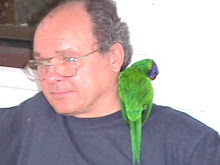.jpg) a typical bridge along the Trent & Mersey Canal
a typical bridge along the Trent & Mersey CanalThe eventual trip tally managed to crawl over the one century mark at 101 [65 for Staffordshire]. That total includes two lifers, the “megatick” Red-necked Phalarope Phalaropus lobatus [thanks largely to Les Ditchburn of Tewkesbury] and the Mandarin Duck Aix galericulata on Rudyard Lake [which we found ourselves].
The more astute followers of this blog over September [2010] will no doubt almost immediately have noted the discrepancy in accounts. In an earlier blog, “TWO DAYS- TWO LIFERS,” I claimed the Belvide Black Tern Chlidonias niger [courtesy of Steve Seal of “Staffordshire Birding” fame] and the aforementioned Red-necked Phalarope as two consecutive lifers ticked over two consecutive days. There was no attempt on my part to deceive [or “string”]. At the time I believed it to be an accurate call.
Such are the joys of modern technology! Prior to our departure for the UK I had copied both my then current Life and Year Lists onto a usb stick using Microsoft Excel 2007. My sisters in Rugeley still operate on Excel 2003 and to my horror I discovered that while the Year List opened without any difficulties, the Life List remained unreadable. That rather upset the well-planned apple-cart of checking lifers on the run.
Here, back home, both my now deceased computer [Windows XP running Microsoft 2007] and my new computer [Windows 7 running Microsoft 2010] opened the Life List to display that Black Tern had been recorded in the London area [Staines Reservoir] in May 1997. The Belvide bird was our second only view of the species; our third brief glimpse was at Slimbridge the following day.
On the other hand, the Mandarin Duck almost slipped by unnoticed until I was transcribing field notes into the computer, again back here in Nanango. Both of us spotted the bird gliding into the water from the bank and simultaneously called it Mandarin Duck, an unmistakeable male.
The malfunctioning usb [or simply the inability of my sister’s 2003 system] didn’t help although I suspect that the root of the problem was that we’d both seen the bird before, at Slimbridge – as a captive exotic so consequently had excluded it from any of our previous lists. Out of sight [on any list], out of mind. The exact details had clearly become a little confused. The bird was known to us, ipso facto it was already on that inaccessible Life List. It wasn’t.
Four major bird groups are represented, accounting for some 85% of all species recorded during September. While the passerines show as the largest single group, 41%, the combined top three non-passerine total 44%. The remaining 15% are all other non-passerines coming in at lower species counts and include members of nine other avian orders: podicipediformes [2 species]; pelecaniformes [1 species]; ciconiiformes [2 specie]s; galliformes [2 species]; gruiformes 2 species]; columbiformes [3 species]; strigiformes [1 species]; coraciiformes [1 species] and piciformes [2 species].
In essence the basic passerine/non-passerine split came out at 60/40.
On leaving Australia the 2010 Year List stood at 167 species. Given that the Trip List [UK birds] stands at 101 it would seem only logical that at the end of September the new year tally stood at 268 [the Common Myna at Abu D’habi making no difference to the count]. It didn’t quite pan out mathematically as of course we share a number of species and six were already listed for 2010 – including the humble House Sparrow Passer domesticus first recorded on the streets of Nanango itself. For the more arithmetically challenged, that made a Year List [at the end of September] of 262 species.
It currently stands at 270.
Scenes from Seven Springs on Cannock Chase
.jpg)
The Woodpigeon had us puzzled. Back in 1999 it was a woodland species rarely seen beyond the barnyard. It appears to have usurped the old Rock Pigeon [Dove] as the most common urban bird. They were even on chimney-pots along Attlee Crescent.
Back in the late 1990s we travelled especially to central Wales to see the Red Kite [with a later brief glimpse of one along the M40 out of London]. They appear to be winning, certainly we came across them in several Welsh spots.
But perhaps the most obvious difference in eleven years was not the birds or the birders – the UK has long been renowned for its excellence here- but the greenery. The trees seemed taller and greener. The countryside seemed more expansive and greener. In particular the canalside shrubbery seemed wilder, more unkempt and certainly better habitat for a wider range of wildlife.
2010 was supposed to be our last trip to the UK but now… well… who knows? Another trip could well be in the offing. There is still so much more to explore in your green and pleasant land, so many more birds to add to our British List.
In the meanwhile we’ll content ourselves with birding the South Burnett. This morning we paid our third only trip to the Gordonbrook Dam and came up with a couple of crackers but those are not for this blog. Readers are more than welcome to follow my Queensland adventures at:
or, even closer to home, my backyard birding exploits at:
http://www.birdsofallenroad.blogspot.com/ [to be activated anon].




